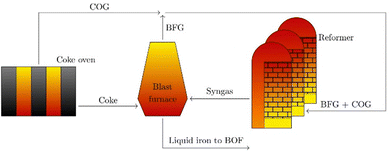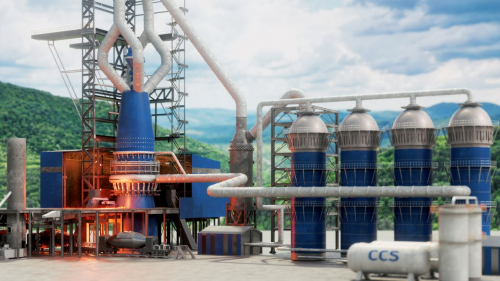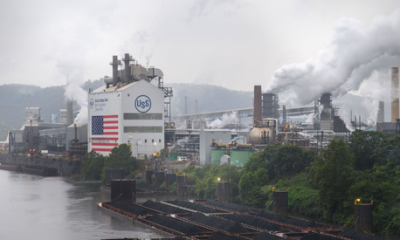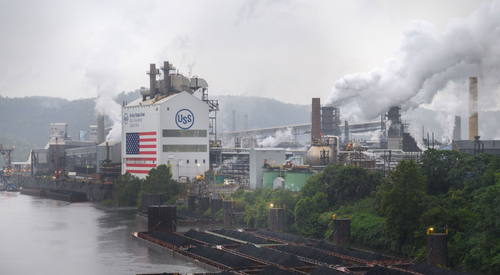Base Metals
New dry-reforming process reduces GHG emissions from pig iron production in conventional blast furnace
Researchers from the Karlsruhe Institute of Technology (KIT) and the SMS group have developed a new dry-reforming process to reduce CO2 emission of worldwide…

Researchers from the Karlsruhe Institute of Technology (KIT) and the SMS group have developed a new dry-reforming process to reduce CO2 emission of worldwide steel production by several hundred million tons per year. It is based on modernizing blast furnace technology with moderate investments and has already been demonstrated successfully in a pilot plant.
The researchers report on the work in an open-access paper in the journal Energy Advances.
Integrated synthesis gas production by dry reforming within a steel mill. Blanck et al.
About eight percent of worldwide CO2 emissions are produced by steel industry. Professor Olaf Deutschmann from KIT’s Institute for Chemical Technology and Polymer Chemistry (ITCP) said that while new hydrogen technologies may bring steel production to a climate-neutral basis in the long term, it will take several years until a sufficient amount of green hydrogen will be available worldwide and new plants will start operation.
The new process developed by Deutschmann’s research team in cooperation with the SMS group, Paul Wurth Entwicklungen, and KIT’s startup omegadot has proven effective at greenhouse gas reduction in conventional plants.
The potential is very high. We expect that backfitting existing blast furnaces with moderate investments will reduce worldwide direct CO2 emissions by two to four percent.
—Professor Deutschmann
Iron is contained in oxidized form in ores and extracted by means of reduction—i.e. the removal of oxygen—with coke in a blast furnace. Coke not only produces the energy required for melting, but also serves as a reducing agent in the chemical reaction.
For this special purpose, coke is produced from fossil coal in a highly energy-consuming process. In our process, we recycle CO2 from the furnace gas using coke oven gas. This yields a synthesis gas with a large hydrogen fraction that can be used as a coke substitute in the blast furnace.
—Philipp Blanck from ITCP, who cooperated closely with the SMS group at the pilot plant
In a conventional blast furnace, pre-heated air is blown into the furnace through nozzles called tuyeres. The preheating up to 1000 °C is performed in Cowper stoves—regenerative heat exchangers (installed in pairs)—in which waste gases of the blast furnace are usually mixed and burnt with natural gas.
For backfitting an existing plant to the new process, the Cowper heaters must be modified. Then, methane and CO2 from the coke oven gas and CO2 from the blast furnace gas are converted into synthesis gas, a mix of hydrogen and carbon monoxide.
Integration of blast furnace, coke oven, and recycling of process gases and process heat reduces CO2 emission of steel production. (Graphics: SMS group)
This process—dry reforming—requires a high temperature that is mainly taken from the process heat of the blast furnace. The synthesis gas is then blown into the blast furnace to support iron oxide reduction there.
Per ton of steel produced, significant amounts of coke can be saved. Specific CO2 emissions are reduced by up to twelve percent.
—Philipp Blanck
The process was demonstrated and validated at Dillinger Hüttenwerke, Saarland, in cooperation with omegadot software & consulting GmbH, a startup of KIT. omegadot has developed a software for the precise simulation and visualization of the process and for supporting scale-up to an industrial plant.
The pilot plant in Dillingen is operated by the SMS group together with Dillinger Hüttenwerke and Saarstahl. Operation is aimed at producing steel with reduced CO2 emissions.
Resources
-
Philipp Blanck, Gilles Kass, Klaus Peter Kinzel, Olaf Deutschmann (2023 “Dry reforming of steelworks off-gases in a pilot plant integrated into a steel mill: influence of operating parameters” Energy Advances doi: 10.1039/D3YA00227F

White House Prepares For “Serious Scrutiny” Of Nippon-US Steel Deal
White House Prepares For "Serious Scrutiny" Of Nippon-US Steel Deal
National Economic Adviser Lael Brainard published a statement Thursday…
How to Apply for FAFSA
Students and families will see a redesigned FAFSA this year. Here’s how to fill it out.
Dolly Varden consolidates Big Bulk copper-gold porphyry by acquiring southern-portion claims – Richard Mills
2023.12.22
Dolly Varden Silver’s (TSXV:DV, OTCQX:DOLLF) stock price shot up 16 cents for a gain of 20% Thursday, after announcing a consolidation of…















